| LIN YAN |
 Calligraphy
by Liu Yongqin © 2010
Calligraphy
by Liu Yongqin © 2010
|
"At the Frontier of Different Universes"
by Michèle Vicat
| 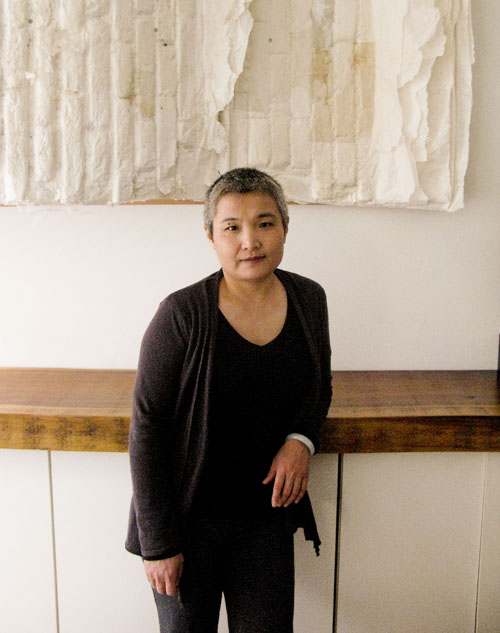
Portrait
of Lin Yan, photograph © Michèle Vicat, 2010 |
Lin
Yan remembers looking at art in the Centre George Pompidou
in Paris and liking it but being
unable to relate what she saw with the city around her. “I
could not find the intimate connection between the work exhibited
and the culture which the city valued,” she says. “I
understood that I had to come to America to connect with another
part of culture. I felt I had to come to New York to understand
contemporary art.”
Lin Yan, who was born in 1961, belongs to a generation of artists
that received a strict education in drawing and classical western
realist painting. Besides technique, she learned the perseverance
necessary to attain the level of perfection expected by her
teachers at the prestigious Central Academy of Fine Arts (CAFA)
in Beijing. She was educated in an atmosphere of intense competition.
Progress on the work itself was the rule. It was the requirement
to be noticed, to be considered the best. The system gave very
little individual freedom to the average student. But Lin Yan
did not come from an “average” environment. Her
parents and maternal grandparents had already established themselves
as respected painters in China. They provided her with the
necessary link to connect her education to a cosmopolitan world
and to endow her a sense of exploration and experimentation.
|
|
Her maternal
grandfather, Pang Xunqin (Hiunkin Pang), was trained in Paris
from 1925 to 1930, and her grandmother, Qui Ti (Schudy), studied
oil painting in China and Japan in 1928. They brought the colors
and techniques of Post-Impressionism and Fauvism back to China.
Pang Xunqin created the Storm Society, an avant-garde group
in Shanghai. Qiu Ti was one of China’s first female oil
painters. Pang Tao, Lin Yan’s mother, was a visiting
artist at CAFA’s studio in Paris and did research at
the Ecole des Beaux-Arts for a year, where she became the first
Chinese professor to depart from realism. Lin Yan’s father,
Lin Gang, studied western art in the Soviet Union. The family’s
involvement in modern art made it a target for radical political
movements in China. The fact that Lin Yan’s grandfather
had established China’s first school of modern art and
design resulted in his being labeled a “Rightist” for
more than twenty years. Lin Yan’s parents were sent to
the “5.7 Reform Camp” during the Cultural Revolution.
Lin Yan was left behind in Beijing, with a succession of different
families.
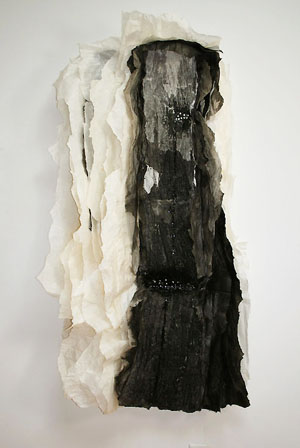
Lin
Yan, "Tree" series, Xuan paper and ink,
45" x 12" x 2.82", 2010 © Lin Yan
|
When she started her college education at CAFA in 1981, Lin
Yan quickly drew the line between what was expected from
her
as a student and what she could obtain as the daughter of her
rehabilitated parents who taught and lived on campus. She had
access to books only available to faculty members. The privilege
enabled her to look at things differently and to develop her
own opinions. She was fascinated by the way Kandinsky related
color and music together. It introduced her to abstraction.
But she also realized that she had to be careful; she needed
to give her teachers what they expected from her. At home,
she kept a personal sketchbook for her abstract work. Her parents
warned her that she would never find a job if she persisted
in her fascination exclusively with abstract art. But she had
already made her choice. The path towards abstraction would
provide a central spine for her own contradictions to dialogue
with each other rather than resulting in a collision.
Lin Yan graduated from CAFA in 1984 and taught in a middle
art school annexed to CAFA. She applied and was accepted to
several universities in the United States, but decided on the
spur of the moment to go to Paris. “My mother was in
Paris,” she explains. “She found a sponsor for
me and sent my portfolio to the Ecole des Beaux-Arts, which
accepted me. It was a turning point in my life. I was excited
to be away from home and to meet so many interesting people.
Although I loved Paris, I was still thinking about America.
I had come from China, a country with a long history. I was
now adjusting to life in another traditional culture. I felt
a bit overwhelmed in trying to find who I was. The sky in America
seemed higher to me.”
During the year spent at the Ecole des Beaux-Arts, she studied
how to make and use artistic media and techniques. It was an
educational springboard, which expanded her options. This established
the foundation for her to explore the materials she was to
use in her art over the next twenty-five years. She later discovered
the multiple possibilities of paper, a medium unique in Chinese
art. She also learned that she could afford to be different.
She did not have to compete with other students to succeed.
She no longer expressed herself by simply reproducing a model.
Instead, she began to feel her work and through that to discover
what was inside her.
The sophistication of Paris spoke deeply to the young girl.
She could relate to the city’s old buildings as well
as its culture and history. Beijing and Paris have that in
common. A discovery was the light of the Ile de France. It
was the light painted by the Impressionists. She could finally
connect it to their paintings. Her relationship with the city
was romantic. When it came to contemporary art, Lin Yan found
it difficult to relate the works in the Centre George Pompidou
with what she saw around her. She could not see the intimate
connection between the work exhibited and the culture emanating
from the city. She would have to go to America to find that.
Her dream had always been to go to the United States and very
precisely to New York.
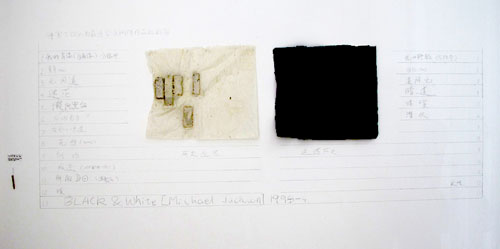
Lin
Yan, "Give Me a Title #C and #D," Series started in 2009,
© Lin Yan |
Before going
to Paris, she had pointed her finger close to New York on a map
and applied to different schools. The University
of Pennsylvania at Bloomsburg offered her a full scholarship.
On a map, it did not look that far away. When she arrived in
the United States, she took a bus, confident that it would
only be a short trip to Bloomsburg. After two hours, and still
not close to her destination, she said to herself “Whatever!” She
was in the country that would give her the potential to find
her own space. A space that connected her directly to contemporary
art without compromise.
As with many artists who live between two cultures, the process
of assimilation (or, at least, the understanding) of the new
environment involves an internal reexamination of one’s
home and its traditions. But when Lin Yan went back to Beijing
for the first time in 1994, she could barely relate her memories
to the reality that confronted her. Entire chunks of the old
neighborhoods were gone. The soul and the pace of Beijing had
been altered. “The old city was almost gone,” Lin
Yan says. “It was a mess of new high-rise buildings.
Through the dusty air, you could see everywhere that the old
landmarks were being demolished and replaced with poorly designed
new buildings. The philosophy was that only new things were
good. It’s really sad to watch. Old Beijing was well
designed as a whole. Although it was in a very bad condition
after all those turbulent years, you could still see that the
combination of landmarks was like a poem. The rhythm of the
city was like endless story telling. Now you can only find
few soulless, commercialized, isolated, repainted traditional
landmarks.”
|
|
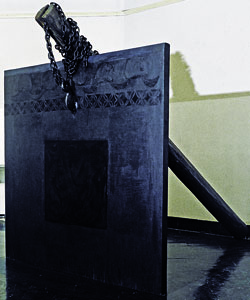
Lin
Yan, "Qi #2-To My Hometown",
Oil on woodboard, with
chain & wood,
83" x 76" x 100", 1994, © Lin Yan |
Her
first black series Qi is a reflection on deterioration. Qi
#2 -To My Hometown is at first very disturbing, nearly violent. The
work depicts the shock experienced by the artist. It is a primal
scream, expressing contradictory but inevitable forces. We are a
world apart from the stereotypes of what was old Beijing. But the
work is not a reference to the physical aspect of the city. It is
a quest. How do you go back to your roots? What fragments would you
put in the suitcase called memory? For Lin Yan’s generation
of artists, there was a Manichaean division of the world between
the communist society they came from and the capitalism they encountered
on their arrival in the United States. But that dichotomy was already
disintegrating when she returned home. Beijing was suddenly under
the yoke of an intransigent capitalism. The destruction of traditional
environments expressed how the Celestial Empire had finally reached
heaven! Lin Yan found the worst of a capitalist society. It was unexpected
to someone trying to re-connect with her own society and its values.
The cultural edifice was on its way towards annihilation.
From that point on, Lin Yan started a voyage that brought her deep
inside herself by consciously eliminating external distractions. Utopia
was gone. She had seen the materialistic transformation of what made
her youth. New materials, new heights, new volumes and new proportions
became the new core of her society. She needed to find a point of equilibrium
that would help her to resolve the tensions between her two worlds,
the East and the West; between the origins of her life - her memory
- and the adoption of her adult life - her history.
Her work became more and more “minimalist.” It took the
path of bringing stories together, a transaction by which she bridges
duality, conflict and contradictions.
Her palette of black and white helps her to go to the essence of abstraction. “There
is nothing much to talk about” says Lin Yan in an interview given
to art curator Liu Libin in 2006. A definition like a scalpel: there
is no compromise. To discover the true nature of the world, one must
find oneself.
Lin Yan believes that, as an artist, she can take old patterns and
old techniques to create something new.
Black and white are the fundamental colors of classical Chinese art.
White is the natural color of paper. Black is the color of ink, the
vehicle that allows the transmission of ideas. Combined, paper and
ink are the memory, the DNA of Chinese culture. Grey/Black is also
the color of Beijing. The original houses in the “hutongs” (small
alleys) were built with grayish bricks and tiles. Black was considered
the “king” of colors in ancient China. It is associated
with water, one of the five elements that compose nature. Black equally
plays with white in the unity of Yin and Yang in the search for harmony.
To reach infinite variations in her black palette, Lin Yan mixes different
black oil colors with mat or gloss media to create subtle feelings.
She also uses acrylic, tempera or wax. “Black is not a unique
color. It has a complete palette. From Chinese paintings, I learned
how far I could go with only black. For ten years, I used different
blacks on different media. Since 2005, I have used only ink. I used
different Chinese paper as media too.” Quite naturally, Lin Yan
came to use handmade xuan paper and mulberry paper (xuan zhi and pi
zhi). Each kind includes a wide variety of paper made from the bark
of a type of elm tree or mulberry tree. Created during the Tang Dynasty
(7th century AD), it was used largely by painters and calligraphers.
Lin Yan’s choice for these papers was natural in the sense that
they are common paper, and consequently intrinsic to Chinese culture.
With these two extremes, black and white, she had an enormous palette
of variations to play with. She could then compose much more with the
effects rather than the representational forms of objects.
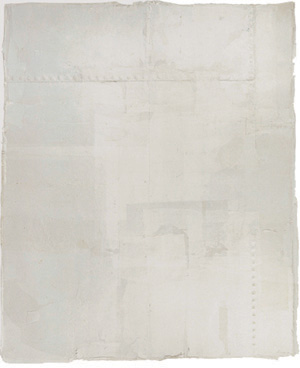
Lin Yan,
"Curtain #1", Xuan paper, 94" x 78", 2005,
© Lin Yan |
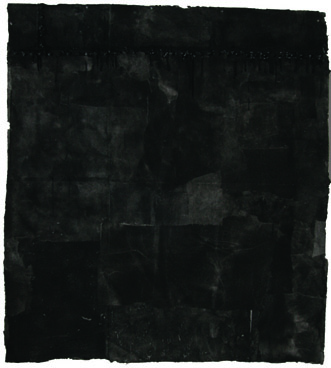
Lin
Yan, "Raining Inside II", Ink, resin and
Xuan paper, 75" x 67" 2006, © Lin Yan
|
In pieces like Curtain
#1 and Raining Inside II, we can find a historical richness of white and
black. And because of this tradition, there is
also a possibility for openness, for new superimpositions that the
artist has to confront the passing of her own days with time. She is
preserving her heritage in an essential way, not a representational
one. If physical details appear here and there, like rivets, they serve
as an invitation to memory. They are details whose significance has
already changed. In ancient China, important doors, such as the gates
of Beijing’s Forbidden City, were covered with golden doornails.
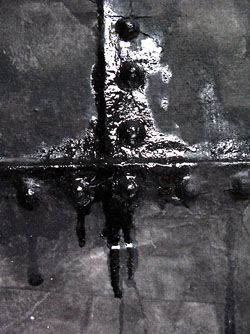
Detail
of rivets in Lin Yan painting.
© Michèle Vicat 2010 |
Rivets also belong
to industrial architecture. In her former studio in New York, Lin Yan
had a metal floor and brick walls. What appears
at a quick glance to be universal (brick walls and rivets for example)
can actually express different realities. The implications are different
depending on the context. “I find myself flowing between categories
or borders rather than resolving the tension between representational
and abstract forms or, by implication, tradition and change,” elaborates
Lin Yan in an interview given to Scott Ritter in 2006. (Lin Yan, Echoes
in the moment, catalogue published by China 2000 Fine Art).
Architecture, painting and sculpture have an impact on her work beyond
their own specificities. Lin Yan started to be interested in space
during her graduate studies in America. She also understood that she
could not abandon painting, more specifically the essence of painting.
She did not want to reproduce objects, flowers, and humans. She knew
she could do that, very well indeed. She realized that the focus was
no more the painting itself. Dynamic relationships coexist between
the painting, the wall and the space around. She then decided to use
a material that would bring her this flexibility: the xuan paper. She
needed to construct a new space in which no frame, no border would
delimit her vision. “When I have a solo show,” she told
us in her Brooklyn studio, “I will see the space first, and then
design each work individually, to shape it for that space. So, my work
evolves from a unique shape to accommodate a single wall to different
shapes to accommodate a space. I like sculpture and architecture and
I conceive my work within these orderliness. I start to think about
a space, and this is not in two-dimensional forms. There is a three-dimensional
element in my work.” The dilemma is how to integrate painting,
sculpture and architecture. How do you link them? Her instinct is to
re-think painting as something “simple.” Something that
goes to the core of her intimacy.
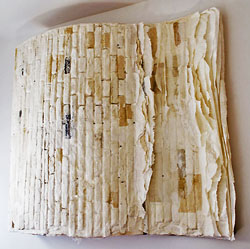
Lin Yan,
"Remaking", Xuan paper, ink and wax, 78" x 78" x 18", 2008, ©
Lin Yan |
In Remaking,
done in 2008, she offers us an immaterial diffusion that brings us
to the frontier of universes where conflict and duality
echo the transaction the artist has to constantly re-evaluate in
order to bring her stories together. It is like the Yin and Yang:
making
things work together. Here the white finds a myriad of vocabularies.
It is rich, dense, theatrical, and textural. For centuries, Chinese
artists used paper as a flat surface. They did not bend it; they
did not compose with it. Lin Yan finds her freedom by reflecting
on traditional
culture and by proposing a radical transformation. “Tradition
could help me (to) get out of tradition, just as contemporary ideas
could help me get into tradition,” she explained to Scott Ritter
in the same article. The loop is closed and reconnects the infinity
of our aspirations.
Lin Yan uses
different moulds for her work. One that she took from an old brick
wall in Beijing is fiberglass. She also uses a plaster
or rubber mould taken from the metal floor of her former studio in
New York. She has recently started to use one made from tree bark.
Beijing and New York are revealed in a new interpretation that we
can find in the sculptural effect
that she gives to the paper. She paints her paper in different
shades of black with ink and water.
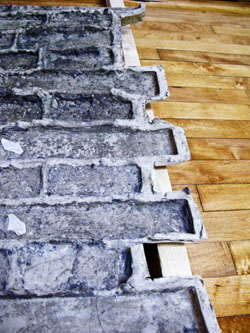
Detail of a mould |
She carefully arranges and mounts layer after layer of xuan paper
into her moulds. The layers are encrusted into the mould with the
help of a traditional brush made from the fibers of a palm tree
(zongshu.) The accumulation of sheets forms a flexible cast that
she will shape
in different arrangements. Her paper then takes a new strength,
an abstract transmutation. The whole process creates an imaginary
sculpture
that dialogues with something that is very flat to start with:
the process of a painting. Lin Yan pushes the envelope to find
a kind
of order within the complexity and duality of genres (painting/sculpture;
abstract/non-abstract) and of visions (Yin/Yang; East/West; feminity/masculinity.)
The duality does not involve rivalry, opposition or intransigence.
It is an inward notion that opens a path for us.
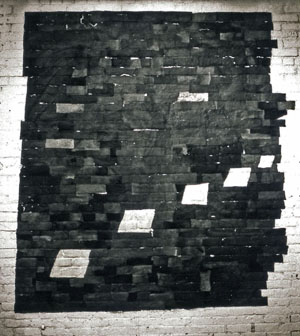
Lin Yan,
"Path", Ink on Xuan paper mounted on the wall, 96" x 80", 2002,
© Lin Yan |
| Path (2002)
lets us walk along an imaginary “Fil d’Ariane” (Ariadne’s
Thread), a path blazed in the silence of our individual existence
stripped bare. The gallery’s brick wall is covered with
many brick-sized inked papers imbedded in the artist’s
visual memory. Their echo is personal. The white patches, acting
as stepping-stones, lead us to the fluidity of our silent voice,
the voice that questions our cultural memory. They are like
sediment that delicately accumulates at the bottom of an ocean,
and whose mystery lightly touches us. It is the fusion of the
whole, the integration that opens the path to the deepest questions
about our past, our present and our future. But do not these
three dimensions in time form one? |
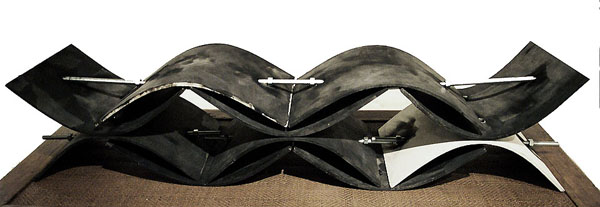
Lin Yan,
"Untitled", Ink, Xuan paper collage on wood with steel, 68" x
13" x 16", 2003, © Lin Yan
For more information about Lin Yan and to see more of her
work, visit her website
http://www.linyan.us |
|
All material
copyright 2010 by 3DotsWater |












